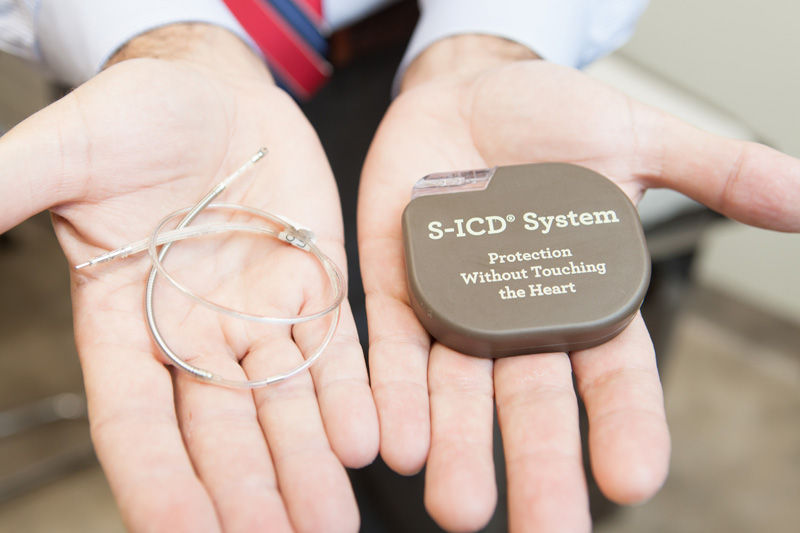The human heart is essentially an eight-to-ten ounce electronic device. When the heart’s electric impulses fail or misfire, as they do for more than four million Americans, it is a problem that requires much more for repair than a quick trip to Radio Shack or Best Buy.
Dr. Michael Greene at Treasure Coast Thoracic Surgery and the Sebastian River Medical Center has been helping to “mend” broken – or at least malfunctioning – hearts since 1991 and the newest tool in his arsenal is the “subcutaneous implantable cardioverter defibrillator” or S-ICD.
For those who never thought of the heart as an electronic device, here’s a quick schematic view: Electrical impulses are what make the heart beat. Those impulses come from the sinoatrial node at the top of the heart’s upper-right chamber. They cause the contractions that pump blood in and out of the heart muscle’s other chambers and onto the rest of the body. No batteries are required.
Sometimes, however, those electrical impulses can go haywire, causing the heart to beat too fast, too slow, or too erratically to do its job. If the heart beats too quickly, for example, its chambers do not have enough time to fill up with and pump blood to the rest of the body, which can lead to ventricular fibrillation and deadly cardiac arrest.
The first implantable heart defibrillation device came onto the scene in 1980 at Baltimore’s Johns Hopkins hospital. With the aim of recognizing electrical malfunctions inside the heart and automatically providing a corresponding electric shock of its own to get the heart muscle back to its proper rhythm, the device worked well and defibrillators quickly gained widespread approval and use worldwide. Batteries, however, were definitely required.
The next few generations of implantable defibrillators ran electrical wires through blood vessels directly into the heart. That not only increased the chances of infection inside the heart muscle, it also meant the heart itself received the full jolt of the electric shock sent to restore its normal rhythm. Plus, sometimes those electrical wires wore out.
In a slow, measured tone Greene repeats the statistics from the American Heart Association that 300,000 people will die this year from sudden cardiac events but adds that he thinks these S-ICDs can help change that.
For example, the new devices, says Greene, are more durable and have a much more refined ability than their predecessors to discern between non-lethal heart malfunctions or arrhythmias and those that do pose a threat to life. Moreover, the S-ICD system delivers its electric shock through a lead that runs just under the skin or “subcutaneously” so it’s near but not actually touching the heart muscle.
The control unit of these new S-ICDs with its lithium battery-powered electric pulse generator and miniaturized diagnostic software system is implanted by a thoracic surgeon such as Greene with a small, (four-to-five inch), incision just below the latisimmus muscle on the rib cage a few inches below the arm pit. From there, a thin tube-like lead runs subcutaneously across the chest towards the heart muscle.
Dr. Martin Burke, director of the Heart Rhythm Center at the University of Chicago, says “This makes the system enticing for younger patients with risk of cardiac arrest who currently don’t get the standard systems because of probable failures of those systems over time. The heart beats 30 million times a year and those beats put wear and tear on those wires,” but the new S-ICDs don’t have that problem.
WebMD reports that the new S-ICD devices do come at something of a premium, but not a shockingly high one. With a price tag in the neighborhood of $24,000, (including hospital fees, the implant procedure and the device itself), that’s roughly $4,000 more than a standard implantable defibrillator. Depending on insurance or Medicare deductibles, most patients will likely pay far less than that out of their own pockets.
With any defibrillator, Greene says, there are some caveats potential recipients should review with their cardiologist or thoracic surgeon. For example, he points out that, while there are currently no laws in the U.S. restricting people with defibrillators from driving an automobile, driving might not be a good idea, depending on how frequently the device has been called on to correct an arrhythmia.
Additionally, going through airport security can be an unexpected adventure with any kind of defibrillator; however, as Greene points out, the S-ICD manufacturer provides special identification cards that should smooth the way with security personnel.
Despite any inconvenience, Greene says the S-ICD device is an impressive step forward. It weighs, he says, only 70 grams, while the original versions tipped the scales at close to 300 grams, and since no leads, wires or electrodes run into or through the heart muscle itself, the implant procedure is both simpler and safer.
According to Greene, S-ICDs only garnered both FDA and Medicare approval within the past six months – though other sources say it’s been a bit longer. He says, as far as he knows, he’s the only thoracic surgeon in this area prepared to perform an implant procedure with the new device today.
With 24 years of repairing malfunctioning hearts under his belt, Greene seems genuinely excited about the potential of S-ICD implants for a wide variety of heart patients.
Dr. Michael Greene is at Treasure Coast Thoracic Surgery at 816 U.S. Highway One, Sebastian and is affiliated with the Sebastian River Medical Center. The phone is 772-581-5848.

